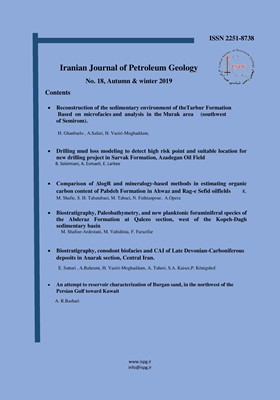Comparison of ΔlogR and mineralogy-based methods in estimating organic carbon content of Pabdeh formation in Ahwaz and Rag-e Sefid oilfields
Subject Areas : PetrophysicsMahdi Shafie 1 , Seyed Hassan Tabatabaei 2 * , Morteza Tabaei 3 , Nader Fathianpour 4 , Ali Opera 5
1 -
2 -
3 -
4 -
5 -
Keywords: Organic carbon content, Source rock, Ahwaz field, Rag-e sefid field, ΔlogR method, Mineralogy based method,
Abstract :
One of the most common and relatively accurate methods for determining the amount of organic carbon in rocks in the oil and gas exploration potential is the Pyrolysis family, a standard example of which is the first rock pyrolysis method. Based on the study of the core, this method explores the potential of oil and gas resources in rocks. One of the important and valuable parameters in determining the potential of oil and gas resources is the determination of TOC. The purpose and motivation of this research is to compare the ΔlogR method and the mineralogy-based method for calculating the total amount of organic carbon in the source rock. It has the desired accuracy and relatively low cost. The fields studied in this study are two fields of Ahwaz and Rag-e sefid. These fields are among the potential fields of southwestern Iran for more detailed investigation and estimation of organic carbon content. In this research, software studies have been performed through IP software, using which the petrophysical data of each field have been calculated and compared, and finally, its results have been compared with actual TOC values. Input data in the mineralogical data method include density log, neutron porosity log and gamma log, and input data in the ΔlogR method include acoustic and resistivity logs. According to the fields, the most appropriate methods (in terms of R2) in Ahwaz and rag-e sefid fields are the mineralogical data method and the ΔlogR method, respectively. Also, in terms of cost, precision and accuracy parameters, the best method discussed in this research is R2 mineralogical data in Ahwaz and Rag-e sefid, 0.94 and 0.61, respectively. After this, the ΔlogR method comes second.
]1[ ظهراب زاده، م.، (1385). "مطالعه زمین شناسی مخزن نفت آسماری میدان نفتی رگ سفید". گزارش شماره پ-5954، مناطق نفت خیز جنوب، 378 صفحه.
]2[ “فاز تعیین مشخصات زمین شناسی میدان نفتی رامشیر” گزارش پ – 6047، شرکت ملی مناطق نفت خیز جنوب.
]3[ کمالی، محمدرضا و مسعود شایسته.(1387)، "مبانی ژئوشیمی در اکتشاف نفت"، تهران، انتشارات پژوهشگاه صنعت نفت.
[4] Ambrose, R.J., Hartman, R.C., Diaz-Campos, M., Akkutla, I.Y., and Sondergeld, C.H., )2010(, "New pore-scale considerations for shale gas in place calculations": SPE 131772, SPE Unconventional Gas Conference, 23–25 February, Pittsburgh, Pennsylvania, USA.
[5] Anderson, J.A. (1983), "Cognitive and Psychological Computation with Neural Models, IEEE Trans". Syst., Man, Cybern., Vol. SMC-13, No. 5, pp. 799-815.
[6] Heaerst, J.R., Nelson P.H., and Pailet F.L.,)2000(."well looging for physical properties", John whily & sons, Ltd, chilchester.
[7] Herron, S.L., )1991(, "In situ evaluation of potential source rocks by wireline logs, Wireline source-rock evaluation in the Paris Basin": AAPG Treatise of Petroleum Geology: Handbook of petroleum geology, source and migration processes and evaluation techniques (AAPG, Tulsa), 127–134.
[8] Hood A., C. C. M. Gutjahr, and R. L. Heacock, )1975(, "Organic metamorphism and the generation of petroleum": AAPG Bulletin, v. 59, p.986-996.
[9] Hunt, J.M. (1996). "Petroleum Geochemistry and Geology". 2nd Edition. W.H. Freeman and Company, New York. 743 p.
[10] Jacobi, D., Gladkikh, M., LeCompte, B., Hursan, G., Mendez, F., Longo, J., Ong, S., Bratovich, M., Patton, G., and Shoemaker, P., )2008(, "Integrated petrophysical evaluation of shale gas reservoirs": SPE 114925, SPE Gas Technology Symposium, 16–19 June, Calgary, Alberta, Canada.
[11] Kamali, M.R., Fathi Mobarakabad, A. and Mohsenian, E.,(2006), "Petroleum geochemistry and thermal modeling of Pabdeh Formation in Dezful Embayment". Journal of Science (University of Tehran) 32, 1–11.
[12] Russell B. H. )2004(, “The application of multivariate statistics and neural networks to the prediction of reservoir parameters using seismic attributes,” Ph.D. Dissertation, University of Calgary, Alberta, p. 392,.
[13] Rylander, E., Singer, P.M., Jiang, T., Lewis, R., McLin, R., and Sinclair, S., )2013(, "NMR T2 distributions in the Eagle Ford Shale: Reflections on pore size": SPE 164554, SPE Unconventional Resources Conference, 10–12 April, The Woodlands, Texas, USA.
[14] Schlumberger,(1998)."Schlumberger Log Interpretation charts", Schlumberger: Schlumberger Ltd edn.
[15] Schmoker, J.W. and Hester, T.C., (1983). "Organic carbon in bakken formation, united states portion of Williston basin": AAPG Bulletin, v. 67, pp. 2165-2174.
[16] Smagala, T. M., C. A. Brown. and G. L. Nydegger. )1984(. "Log-derived indicator of thermal maturity Niobrara Formation, Denver Basin, Colorado". Nebraska. Wyoming. in J. Woodward. F. F. Meissner, and J. L. Clayton eds., Hydrocarbon source rocks of the greater Rocky Mountain region: Rocky Mountain Association of Geologists, p. 355-363.
[17] Tisso!. B. P .. and D. H. Welte. )1984(. "Petroleum formation and occurrence": New York. Springer-Verlag, 699 p.

